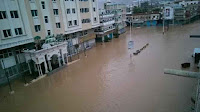One person has died following a series of flash floods which hit Saudi Arabia, Qatar and Bahrain on Wednesday 25 November 2015. The fatality is reported to have occurred in Rimah Province in Saudi Arabia, though details of this event are unclear. Many areas of both countries are suffering from disrupted transport networks, with many roads flooded and often blocked by abandoned cars. Schools and other public services have been forced to close in many areas due to the flooding, as has the US Embassy in Doha, Qatar. Many new development projects associated with the 2022 Football World Cup in Qatar have been particularly badly hit, including the new Hamad International Airport in Doha, leading the Qatari government to announce an inquiry into lax building standards in the country.
Flooding on a road underpass in Ridyah, Saudi Arabia. The Guardian.
Qatar has been widely reported as having received more than an average years rainfall within 24 hours, about 80 mm compared to 75 mm, though this is slightly misleading as Qatar does not receive any rain some years, lowering the average rainfall, and what does fall often arrives in the form of sudden extreme downpours. Flash floods are a common problem in Arabia (and other areas with a dry climate) as protracted periods of dry weather can cause topsoil to dry out completely, making it vulnerable to being blown away by the wind. When rain does arrive it then falls on exposed bedrock, which is much less absorbent, triggering flash flooding as the water escapes over the surface of the ground rather than sinking into it. These floods wash away more topsoil, making the problem progressively worse over time.
Flooding at East Riffa in Bahrain. Gulf Daily News.
Flooding events in Arabia are most common in November and December, though this years weather has been unusually severe. This is the third bout of flooding to hit Arabia in November 2015, with an initial bout of floods associated with Cyclone Chapala at the beginning of the month that has been blamed for fatalities from Yemen to Iran, then a second bout of flooding in Saudi Arabia from the 15th onwards that is thought to have claimed the lives of at least 12 people.
Flooding in Baghdad, Iraq, on 31 October 2015. Ahmed Saad/Reuters.
This extreme weather is thought to be connected with this year's El Niño weather system, which has warmed the Arabian Sea by around 2 degrees centigrade. This warming leads to higher rates of seawater evaporation, i.e. more water entering the atmosphere over the ocean, which in turn leads to more rainfall on land.
Movements of air masses and changes in precipitation in an El Niño weather system. Fiona Martin/NOAA.
The El Niño is the warm phase of a long-term climatic oscillation affecting the southern Pacific, which can influence the climate around the world. The onset of El Niño conditions is marked by a sharp rise in temperature and pressure over the southern Indian Ocean, which then moves eastward over the southern Pacific. This pulls rainfall with it, leading to higher rainfall over the Pacific and lower rainfall over South Asia. This reduced rainfall during the already hot and dry summer leads to soaring temperatures in southern Asia, followed by a rise in rainfall that often causes flooding in the Americas and sometimes Africa. Worryingly climatic predictions for the next century suggest that global warming could lead to more frequent and severe El Niño conditions, extreme weather conditions a common occurrence.
See also...
 Cyclone Chapala makes landdall in Yemen. Cyclone Chapala made landfall in the close to the city of Al Mukalla in
the Hadhramaut region of Yemen early on Tuesday 3 November 2015.This is
the first tropical cyclone to have hit the coast of Yemen since...
Cyclone Chapala makes landdall in Yemen. Cyclone Chapala made landfall in the close to the city of Al Mukalla in
the Hadhramaut region of Yemen early on Tuesday 3 November 2015.This is
the first tropical cyclone to have hit the coast of Yemen since... At least 73 dead following Afghanistan flash-flooding. Seventy three people are known to have died and around 200 more are
still missing following a series of flash floods in the Guzargah-e-Nur
District of Baghlan...
At least 73 dead following Afghanistan flash-flooding. Seventy three people are known to have died and around 200 more are
still missing following a series of flash floods in the Guzargah-e-Nur
District of Baghlan... At least four dead in Ridyadh flooding. Four people including one child are known to have died and at least five
more are missing in flooding in the Saudi capital Riyadh. Heavy rain
began to fall in the desert city on Saturday 16 November 2013, and is
predicted to continue till at least the middle of the week, leading to
floodwaters 4-5 m deep in the worst hit...
At least four dead in Ridyadh flooding. Four people including one child are known to have died and at least five
more are missing in flooding in the Saudi capital Riyadh. Heavy rain
began to fall in the desert city on Saturday 16 November 2013, and is
predicted to continue till at least the middle of the week, leading to
floodwaters 4-5 m deep in the worst hit...
Follow Sciency Thoughts on Facebook.




